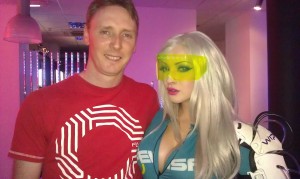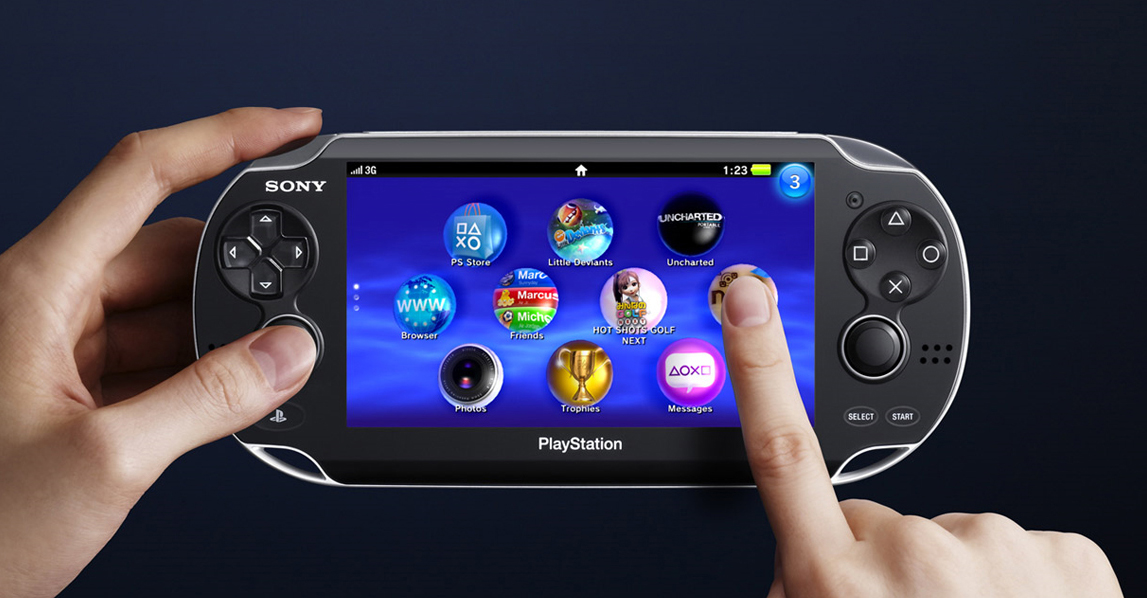This week started of with a chance to have a play with Sony’s new portable gaming console, the PS Vita, at the launch night of the PlayStation Vita Rooms in Glasgow on Monday.
I’d been fortunate enough to get a ticket to the PS Vita Rooms event by entering a draw on Facebook. Having done the same and ending up with an invite for an Access PlayStation event in early 2011, I thought it’d be unlikely for me to score another. But, however you get picked for these things, I was delighted to get one and went along to join the queue on Sauchiehall Street on a cold, but dry Monday night.
After getting in and putting my coat in the cloakroom, I went upstairs to see if I could find and play WipEout 2048, the latest version of the franchise that’ll be a launch title on the Vita. I was delighted to see my old Sony workmate Karl Jones there, standing chatting to the lovely Ami Nakajima. Although Ami had joined the company shortly after I left in 2008, Karl had been a designer during my time on the WipEout team and it was great to see him in Glasgow. We spent about ten minutes chatting before I realised that the venue was getting pretty crowded, so I headed off to get a play of something on the Vita while I had the chance.
The game with the almost no queue was Virtua Tennis, so I got in line for that. I honestly wasn’t expecting much – Sega can be hit and miss when they’re releasing something on a new platform, and for my money the result is seldom a polished game. After a five minute play with Virtua Tennis I was very pleasantly surprised, though. This was my first time holding and using a Vita and I thought it was a great update to the PSP form factor. The game itself felt superb – graphically it was solid and the gameplay was very smooth indeed.
Moving on to a different block of standees that had only a couple of people at them, I got to play Rayman Origins and Reality Fighters. I was very impressed by the animation in Rayman Origins, but after a bunch of goes I kept dying in the same place and being returned to the start of the level, so I gave up on it. Reality Fighters was okay and the tech’ involved in being able to put your own face in the game and fight on an augmented reality stage was cool, but not something I’d play.
Next up was WipEout 2048, which I had to queue for about ten minutes to play. I felt I had to play it just to see what they’d done with the game in my absence. I have such fond memories of being on that team and doing my bit with the website, the back story, and arguing the toss with the designers. I’m not really as big a fan of the game as I used to be, and all the things that turned me away from the series were present – barrel rolls, open sided track sections, and hard to hit weapons pads. But there was no denying how well it played and how good it looked. If I buy a Vita I’ll probably get WipEout 2048 for old times sake – it looks great and plays so well that I could look past the things that annoy me.
Given that this was my first time using the Vita hardware I had gone in with fairly neutral expectations and, to be honest, I was blown away with how great it is to use. Sony have never had any problem making great hardware – it’s usually the software side of it that’s the let down. I’m not talking about the games, I mean the features and functionality of the software for interacting with the hardware. No problems there with the Vita – the front end is as slick as any touch screen device I’ve used.
In fact, my only concern was with games that forced me to use the touch screen to confirm things rather than allowing me the use of the buttons on the device. I always felt this was a huge mistake with early EyeToy games and even Move games on the PS3. For example, EyeToy Play forced you to make hand gestures to select menu options when the pad would be much quicker, and Tumble on the PS3 forces you to point at and select on screen icons for navigating the menus when it would be quicker to press the buttons on the Move controller.
User interaction flaws like this can really take the shine off of new hardware, so it was a shame to see stuff like that on the Vita. What I wanted to do was use the pad to select a menu option or confirmation dialogue and press X to confirm it. But what I had to do in a couple of the games I played was move my right hand from the controls to tap the screen. It seemed silly not to give the option of doing both, as the forced use of the touch screen wasn’t intuitive to me.

After playing WipEout I went back up stairs to talk to Karl and found him reluctantly meeting and greeting nervous gaming nerds. Karl isn’t fussed by the limelight, really, he just wants to make good games and isn’t fond of the hero worship that might come from being a designer on a successful title. So it was handy that Ami Nakajima loves the meeting and greeting side of it!
She was every bit as pretty in real life as she looked in the photos I’d seen and I indulged myself by getting one taken with her. She was as lovely to talk to as she was to look at, too, telling me that because she’d done a bit of cosplay beforehand it was how she’d ended up dressed as an anti gravity ship pilot to help promote the game – a proper community promotion role in addition to the day job she does for Sony.
After chatting with Ami I had a quick play with the games that were on the Vita’s around the WipEout standees, but ended up talking to Karl again to round off the night. I know I’ll get to see the Vita again when it launches, but I figured it might be a good while until I got to see my friend again – the hardware could wait!
When it was time to go I had to dash to the cloak room and then run for my train, making the schoolboy error of forgetting to collect a goodie bag on my way out of the door. Despite that, it was well worth going and I’m really glad I got an invite. The Vita is a brilliant piece of hardware and, despite being on the fence with it before, I’m really keen to get one now.
